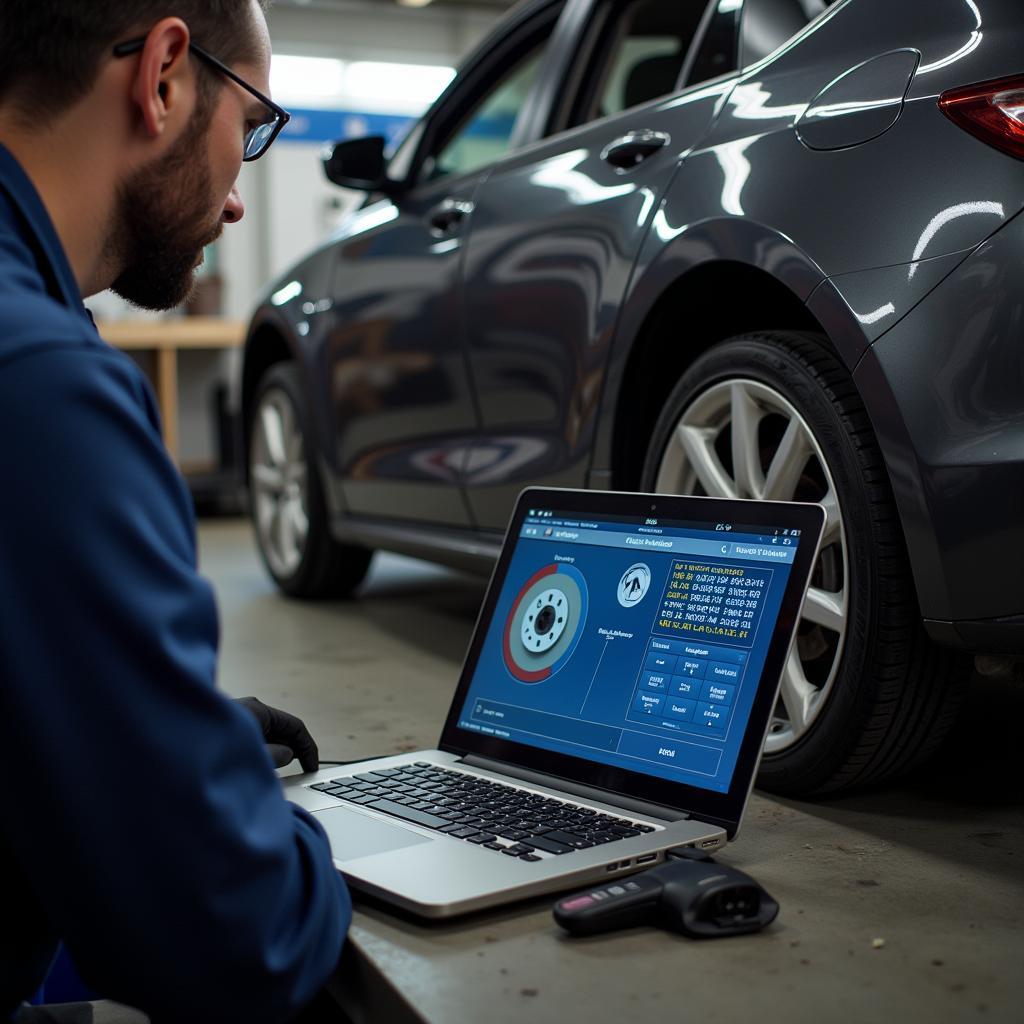The brake warning light on your Chevy Tracker dashboard is a crucial safety feature. When it illuminates, it signals a potential issue with your braking system that requires immediate attention. Ignoring this warning light could lead to brake failure, putting you and others at risk. This comprehensive guide will walk you through the common causes of a Chevy Tracker brake warning light and provide potential solutions to get you back on the road safely.
Common Causes of a Chevy Tracker Brake Warning Light
Several factors can trigger the brake warning light on your Chevy Tracker. Here are some of the most common culprits:
- Low Brake Fluid Level: Your Chevy Tracker, like all vehicles with hydraulic braking systems, relies on brake fluid to transmit force from the brake pedal to the wheels. If the brake fluid level drops too low, often due to a leak or worn brake pads, the warning light will activate.
- Worn Brake Pads: Brake pads are designed to wear down over time. When they become too thin, the brake warning light will turn on, indicating it’s time for a replacement.
- Faulty Brake Caliper: The brake caliper houses the brake pads and pistons that clamp the pads against the rotor to slow or stop your vehicle. A sticking or seized caliper can cause uneven braking and trigger the warning light.
- ABS Issue: If your Chevy Tracker is equipped with an Anti-lock Braking System (ABS), a malfunctioning ABS module or sensor can also activate the brake warning light.
- Faulty Brake Light Switch: In some cases, a faulty brake light switch, responsible for turning on your brake lights when you press the pedal, can also trigger the brake warning light.
Diagnosing the Problem
Before attempting any repairs, it’s crucial to pinpoint the exact cause of the brake warning light. Here’s a step-by-step guide:
- Check the Brake Fluid Level: Park your Chevy Tracker on a level surface and open the hood. Locate the brake fluid reservoir (refer to your owner’s manual if needed). The reservoir will have “Min” and “Max” markings. Ensure the fluid level is within this range. If it’s low, there might be a leak in the system, or your brake pads might be excessively worn.
- Inspect the Brake Pads: If you’re comfortable with basic car maintenance, you can visually inspect the brake pads by looking through the spaces between the wheel spokes. If the pads are less than ¼ inch thick, they need replacing.
- Check for Leaks: Carefully examine the area around the brake master cylinder, brake lines, and calipers for any signs of brake fluid leaks. Look for wet spots or puddles of fluid.
- Consult a Professional: If you’re unable to identify the problem or are uncomfortable working on your vehicle’s braking system, it’s best to consult a qualified mechanic or dealership. They have the expertise and equipment to diagnose and repair brake issues safely and effectively.
Potential Solutions
The solution to your Chevy Tracker’s brake warning light will depend on the underlying cause. Here are some possible fixes:
- Add Brake Fluid: If the brake fluid level is low, carefully add the correct type of brake fluid to the reservoir, bringing it to the “Max” line. However, this is only a temporary solution. It’s vital to have the system inspected for leaks and address the root cause of the low fluid level.
- Replace Brake Pads: If your brake pads are worn, they need replacing. You can do this yourself if you have the necessary tools and experience. However, it’s often best to leave brake pad replacement to professionals to ensure it’s done correctly.
- Repair or Replace Brake Components: If you discover a leak in the brake lines, a faulty caliper, or any other damaged brake components, they’ll need repair or replacement. These repairs are best left to qualified mechanics.
- Address ABS Issues: If the brake warning light is related to a problem with the ABS system, it’s crucial to have it diagnosed and repaired by a qualified technician, preferably one specializing in ABS systems.
Ignoring the Warning: Risks and Consequences
Ignoring a glowing Chevy Tracker brake warning light can have serious consequences, including:
- Brake Failure: Driving with low brake fluid or worn brake pads significantly increases the risk of complete brake failure, making it extremely dangerous to operate the vehicle.
- Costly Repairs: Ignoring the warning light and continuing to drive can exacerbate existing issues, leading to more extensive and expensive repairs down the line.
Preventative Measures
Prevention is always better than cure when it comes to car maintenance. Here are some proactive steps to prevent Chevy Tracker brake warning light issues:
- Regular Brake Inspections: Schedule routine brake inspections with a qualified mechanic, typically every 12,000 miles or as part of your regular maintenance schedule.
- Brake Fluid Flush: Have your brake fluid flushed and replaced every 24,000 miles or as recommended by your owner’s manual. This helps maintain optimal braking performance and prevents internal corrosion.
- Mindful Driving Habits: Avoid hard braking whenever possible. Gradual braking reduces wear and tear on your brake pads and other components.
When to Seek Immediate Assistance
If you experience any of the following alongside the illuminated brake warning light, stop driving immediately and seek immediate assistance:
- Soft or Spongy Brake Pedal: This could indicate a serious issue with your brake system, such as a loss of brake fluid pressure.
- Grinding or Scraping Noises When Braking: This usually signifies severely worn brake pads, meaning the metal backing plate is making contact with the rotor.
- Pulling to One Side When Braking: This indicates uneven braking force and could be due to a stuck caliper or a brake fluid leak.
By understanding the common causes of a Chevy Tracker brake warning light, taking proactive steps to address the problem, and prioritizing regular maintenance, you can ensure the safety and longevity of your vehicle’s braking system.


